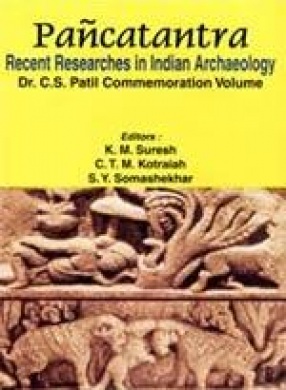
K.M. Purkayastha

Showing all 14 books










The Ramayana is one of the two great epics of India and its influence on the life of Indian people has been great and immeasurable. The ideals pf the Ramayana have gone deep into the core of Indian life and have largely moulded its social, political and cultural fabric and eternal history of India. Rama is an ideal hero the Ramayana describes his character unparalleled in human history.During Vijayanagara period many poets add scholars translated the Ramayana in ...

ENCYCLOPAEDIA OF INDIAN ARCHITECTURE: HINDU, BUDDHIST, JAIN & ISLAMIC: HINDU: This volume of the book entitled 'Encyclopaedia of Indian Architecture' is devoted to the study of Hindu architecture. It has fourty-six chapters. The Chapters in this volume deal with the origin of architecture in India, the architecture of Rgvedic period, the architecture in the later Vedas and Brahmanas, the Vastuvidya in Sutra literature, the settlement patterns, urban planning ...

Hampi, now a semi-urban village is situated on the southern bank of river Tungabhadra in Hospet Taluk, Bellary district, Karnataka played an important role as capital of mighty Hindu empire of Vijayanagara and stood as a bulwork against the onslaught of the northern invaders for nearly two and a half centuries (from 1336 to 1565 A.D.). The Vijayanagara rulers were tolerant towards all religions and constructed temples for Saiva, Vaishnava and Jains at Hampi and ...

Karnataka has a rich temple culture and thousands of temples have been erected by the rulers of different dynasties like Kadambas, Badami Chalukyas, Gangas Rashtrakutas, Kalyana Chalukyas, Hoysalas and the Vijayanagara, as well as by Mahamandalesvars, feudatories, ministers, dandanayakas, savants, trading classes, citizens and devotees. The temple architects freely experimented under royal patronage. Aihole in Hunugunda taluk of Bagalkot district known as ...

This felicitation volume, brought out by the friends and admirers of Shri C.T.M. Kotraiah is to honour him appreciating his memorable services to the development of the Site Museums of the Archaeological Survey of India and his valuable contributions to archaeological research and study. There are eighty four invaluable papers penned by experienced and proficient scholars divulging their recent findings on various topics of scholastic and archaeological interests.

Khajuraho is a small but modernized village situated in the Chhatarpur District of Madhya Pradesh in the central India, played an important role as one of the capitals of the Chandellas, with its famous group of magnificent temple with sculptures, built between 9th and 12th Century A.D., became the religious city of Chandellas. The Chandellas were devoted worshipers of both Vishnu and siva. Vishnu is varioiusly worshipped as Vaikunthanatha, Vamana, Trivikrama, ...


The Kandariya Mahadeva is one of the finest, largest and loftiest temple among the group of the temple of Khajuraho. This was built during the reign of the Chandella ruler Vidyadhar between Circa 1025-1050 A.D. The Chandella rulers were devotees of both Siva and Visnu. Their well-known Siva temples are the Matangesvara, Visvanatha and Kandariya Mahadeva. In this book, the Chapter I and II deals with location and general history of Chandellas. The Chapter III ...

This volume consists of Forty-one research papers penned by Shri C.T.M. Kotraiah, Archeologist, while he was in the service of that august organization, The Archeological Survey of India and even after retirement, in the year 1985. All of them are based on his thorough and thoughtful investigations into the archeological remains spread in that vast but rich site of Hampi-Vijayanagara. All of them were got published by him from time to time in different journals, ...

This volume of the work entitled 'Encyclopaedia of Indian Architecture' is devoted to the study of Islamic architecture. It has thirty nine chapters. The chapters discuss The Sources of Islamic Architecture in India. The Delhi or Islamic Architecture in India. The Delhi or Imperial Style: Its Beginnings under the slave Dynasty, The Thirteenth century Mosques at deli and Ajmer -The Qutb Minar, The Delhi or Imperial style: The Buldings of the Khalji Dynasty, The ...

This volume of the book entitled 'Encyclopaedia of Indian Architecture' is devoted to the study of Hindu architecture. It has fourty-six chapters. The Chapters in this volume deal with the origin of architecture in India, the architecture of Rgvedic period, the architecture in the later Vedas and Brahmanas, the Vastuvidya in Sutra literature, the settlement patterns, urban planning and architecture of Harappans, the residential architecture of Harappans, ...

This volume of the work entitled 'Encyclopedia of Indian Architecture' is devoted to the study of Buddhist architecture. It has twenty four chapters. The chapters discuss Buildings during the Rule of the Early Mauryan Dynasty (c. 400 B.C.): Wooden Origins, Asoka and the Beginnings of the Buddhist School (c.250 B.C.) The Stupa and its Symbolism, Architecture of Sungas, Buddhist Rock -Cut Architecture, Rock-Cut Architecture of Hinayana 2nd Century B.C., Buddhist ...

This volume of the work entitled 'Encyclopaedia of Indian Architecture' Is devoted to the study of Jain architecture. It has eighteen chapters. discuss Iain Rock-cut caves from Pabhosa, Khandagiri and Udayagiri, Jain caves at Ellora, Jain caves of Maharashtra, Jain caves at Dharasiva, the Jabareshwar temple at Phaltan, Jain Architecture of south India, Jain temples of the Pallavas and the Cholas in Tamilnadu, the Parsvanatha Nagraja temple of ...
